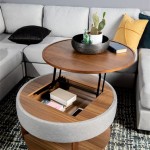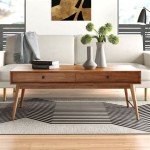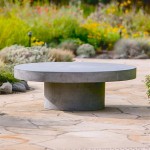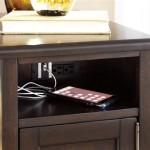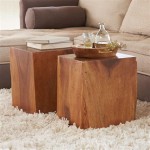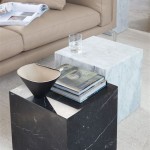How Tall Should an End Table Be?
Determining the optimal height for an end table is a crucial aspect of interior design, contributing significantly to both the aesthetic appeal and functional utility of a living space. End tables, designed to flank sofas, armchairs, and beds, serve as convenient surfaces for lamps, beverages, books, and other everyday essentials. Selecting the correct height ensures comfortable access to these items and promotes a balanced and harmonious room arrangement. The ideal height is rarely a fixed measurement, instead it’s a variable dependent on several factors related to the surrounding furniture and the typical usage patterns within the space.
The primary considerations when determining the appropriate height of an end table revolve around the height of the adjacent seating. A table significantly lower than the arm of a sofa, for instance, can create an awkward reach for users placing items on or retrieving them from its surface. Conversely, an end table noticeably taller than the seating can appear visually unbalanced and disrupt the overall flow of the room. Therefore, a careful assessment of the existing furniture's dimensions and the intended functionality of the end table is essential before making a selection.
Beyond functional considerations, the aesthetic impact of end table height cannot be overlooked. End tables play a vital role in creating a visually pleasing and balanced interior. Their height contributes to the overall symmetry and proportion of the room, influencing how the eye moves through the space. Choosing an end table height that complements the surrounding furniture establishes a cohesive and visually appealing environment, enhancing the overall design scheme.
Matching End Table Height to Seating
The most fundamental guideline for selecting the correct end table height involves matching it to the adjacent seating. The general rule of thumb is that the end table should be approximately the same height as the arm of the sofa or chair it accompanies, or slightly shorter. This allows for easy access to items placed on the table without requiring the user to reach up or down excessively. A range of 1-2 inches above or below the arm height is generally considered acceptable, providing some flexibility to accommodate personal preferences and specific design considerations.
To accurately determine the ideal height, measure the height of the armrests of the surrounding sofas and chairs. Once this measurement is obtained, look for end tables within the recommended range. If the armrests are of varying heights, prioritize the armrest height of the most frequently used seating. In situations with a significant difference in armrest heights, consider using end tables of differing heights to better accommodate each seating area individually. This approach helps maintain optimal functionality and visual harmony despite the varying dimensions.
Consider also the style of the seating. A low-slung modern sofa might necessitate a lower end table, while a more traditional armchair with higher arms would likely require a taller table. The overall aesthetic should guide the decision, ensuring that the end table complements the style of the seating without appearing disproportionate. Pay attention to the leg height of the sofa or chair as well. If the seating has very short legs, a slightly lower end table may be more visually appealing, even if it falls slightly below the ideal armrest height range.
For reclining sofas and chairs, the measurement should be taken when the furniture is in its upright position. This ensures the end table remains at a comfortable and accessible height even when the seating is reclined. Avoid basing the measurement on the reclined height, as the end table could then become too tall and awkward to use when the furniture is in its standard upright position.
Considering the Function of the End Table
The intended function of the end table significantly influences the optimal height selection. An end table primarily intended for holding lamps needs to be tall enough to provide adequate lighting for reading or other tasks. The height of the lampshade and the user's eye level when seated should be considered to ensure the light is directed appropriately. A taller end table may be necessary to elevate the lampshade and provide sufficient illumination.
If the end table is primarily intended for holding drinks and snacks, a height that allows for easy access is crucial. Avoid choosing an end table that is so low that users have to bend over excessively to reach their beverages. A height slightly below the armrest of the seating is often ideal in these cases, as it provides a convenient surface without obstructing movement or conversation.
End tables used for holding books or magazines should be chosen with consideration for the user's comfort. The height should allow for easy retrieval of reading materials without requiring excessive reaching or bending. If the end table incorporates shelves or drawers, the height of these storage compartments should also be considered to ensure they are easily accessible.
If an end table is intended to serve multiple purposes, such as holding a lamp, drinks, and books, a compromise may be necessary. In such cases, prioritizing the most frequent use and selecting a height that best accommodates this primary function is recommended. Alternatively, consider using multiple end tables of varying heights to cater to different needs within the same seating area.
Aesthetic Considerations and Room Proportions
The height of the end table contributes significantly to the overall aesthetic balance and proportions of the room. An end table that is disproportionately tall or short can disrupt the visual harmony and make the space feel unbalanced. When selecting an end table height, consider the overall height of the room, the size of the surrounding furniture, and the desired aesthetic effect.
In rooms with high ceilings, taller end tables may be more appropriate to fill the vertical space and prevent the room from feeling too cavernous. Conversely, in rooms with low ceilings, shorter end tables may be preferable to avoid creating a sense of confinement. The height of the end table should complement the architectural features of the room and contribute to a cohesive and balanced design.
The size and style of the surrounding furniture should also be considered. Large, bulky sofas may require taller end tables to maintain visual balance, while smaller, more delicate chairs may be better complemented by shorter tables. The style of the furniture should guide the selection, ensuring that the end table harmonizes with the overall design scheme.
Consider the visual weight of the end table. A solid, heavy end table may appear larger than a more delicate, open-framed design, even if they are the same height. The visual weight can influence the perceived height of the table and affect its overall impact on the room. Choose an end table with a visual weight that is appropriate for the size and style of the surrounding furniture and the overall aesthetic of the space.
Experiment with different heights and styles of end tables to find the perfect fit for the room. Use visual aids such as magazines or online design tools to get a sense of how different end table heights will look in the space. Ultimately, the ideal height is one that is both functional and aesthetically pleasing, contributing to a comfortable and visually harmonious living environment.
Finally, don't be afraid to break the rules if necessary. While the guidelines outlined above provide a solid foundation for selecting the correct end table height, personal preferences and specific design considerations may warrant deviating from these recommendations. Trust your own judgment and choose an end table height that feels right for the space and meets the individual needs of the users.

End Table Heights

End Table Height How Tall Should Your Side Be Bedroom Tables

What Is Side Table Dimensions Free Dwg Layakarchitect

Side Table Dimensions Free Dwg Layakarchitect
How Tall Should End Tables Be Next To A Sofa Quora

How Tall Should End Tables Be Higher Than The Couch

How To Choose The Correct Lamp Size Guide Front Door

How To Mix Match Your Coffee Tables Side Early Settler S Home Life

Side Tables And End A Guide To Decorating With Them

How Tall Should End Tables Be Higher Than The Couch
Related Posts

